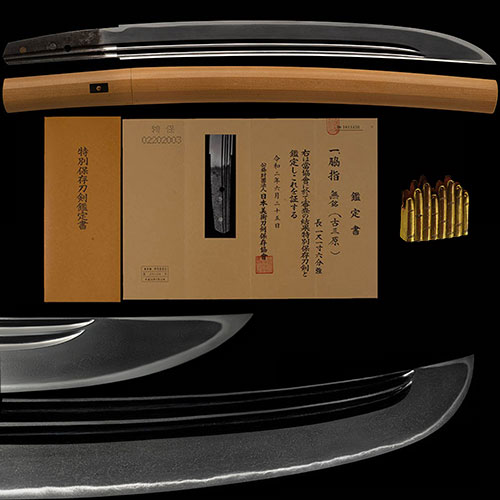
古三原 脇差Komihara Wakizashi
No.587711寸延び短刀 古三原 南北朝時代貞治頃 重要候補 身幅3.3cm 一尺一寸七分Sunnobi Tanto Komihara Nanbokucho era, around Teiji, Juyo Candidate , 3.3cm Mihaba, 35.3cm
ご成約Sold
- 極めKiwame
- 古三原正広Komihara Masahiro
- 登録証Registration
- 東京都 Tokyo 平成16年7月13日 7/13/16(Heisei)
- 時代Period
- 南北朝時代貞治頃 Nanbokucho Era, Around Teiji
- 法量Size
-
刃長 35.3cm (一尺一寸七分) 反り 0.6cm
元幅 3.3cm 先幅 0.0cm 元重 0.63cm 鎬厚 0.00cm 先重 0.00cm 鋒長 0.0cm 茎長 11.0cm 重量 323gHachou 35.3cm (一尺一寸七分) Sori 0.6cm
Moto-Haba 3.3cm Saki-Haba 0.0cm Moto-Kasane 0.63cm Shinogi-Thikess 0.00cm Saki-Kasane 0.00cm Kissaki-Chou 0.0cm Nakago-Chou 11.0cm Weight 323g - 国Country
- 備後Bingo
- 姿Shape
- 平造、庵棟、身幅広く、浅く反り付く。Hiradukuri, Iorimune, Wide Mihaba, Shallow Sori-tsuku.
- 鍛Kitae
- 板目肌に、杢目交り、地沸微塵に厚く付き、地景細かく入る。Itamehada, Mixed Mokume, Jinie entered fine and thick, Chikei entered finely.
- 刃文Hamon
- 直刃調に、浅くのたれて、小互の目交じり、小足入り、小沸つき、金筋かかり、匂口明るく冴える。Suguha-style, Shallow Notare, Mixed small-genome, Small-Ashi enter, Small-Nie-tsuki, Kinsuji-kakari, Nioikuchi is bright and clear.
- 帽子Boushi
- 直に小丸、深く返る。Suguni-Komaru, Fukaku-kaeru(Deep Return)
- 茎Nakago
- 大磨上、先栗尻、鑢目切、目釘孔四内三埋。Oh-suriage, Sakikurijiri, Yasurimegiri, Three of the four Mekugiana are filled.
- ハバキHabaki
- 金色絵竹垣図一重。Kiniroe Takegakizu single
- 彫物Carving
- 表裏に二筋樋を掻き通す。Scrape two Hi lines on the front and back sides.
- 説明Drscription
- 三原派は、鎌倉末期正和頃の正家を祖とすると伝え、室町期にかけて備後国三原の地に栄えた。備後国には大和の諸大寺の荘園があったため、大和物の影響が随所に伺われる。
この刀は、3.3cmと広く、浅く反りが付く南北朝の姿で、杢目肌よく練れて、地沸厚く付き、地景細かく入る冴えた地鉄に、金筋掛り匂口明るく冴える直刃調の刃を焼き出来が良い。重要候補の一口である。The Mihara school is said to have originated from Masaie during the late Kamakura period and Shōwa period, and flourished in Mihara, Bingo Province during the Muromachi period. Bingo Province had the manors of the great temples of Yamato, so the influence of Yamatomono can be seen everywhere.
This sword is 3.3cm Motohaba, Shallow Sori-tsuku Nanbokucho appearance, with Mokume-hada-nerete, Jinie entered thick, Chikei entered finely in clear Jitetsu, Kinsuji-kakari, Nioikuchi is bright and clear. Suguha-style, It works well in sword. This sword is Juyo Candidate.


